-
Equipments
-
-
NEWS
- Double planetary mixer new t...
- Multiple paddle options of D...
- Double planetary mixer is th...
- Multiple mixing tanks with d...
- Double planetary mixer for c...
- Double planetary mixer can b...
- Double planetary mixer has E...
- Double Planetary Mixer Excel...
- Principle of asteroid rotati...
- Efficient and uniform mixing...
-
Contact Us
Or Contact Info
-
Coating
-
-
NEWS
- Double planetary mixer new t...
- Multiple paddle options of D...
- Double planetary mixer is th...
- Multiple mixing tanks with d...
- Double planetary mixer for c...
- Double planetary mixer can b...
- Double planetary mixer has E...
- Double Planetary Mixer Excel...
- Principle of asteroid rotati...
- Efficient and uniform mixing...
-
Contact Us
-
Adhesives
-
-
NEWS
- Double planetary mixer new t...
- Multiple paddle options of D...
- Double planetary mixer is th...
- Multiple mixing tanks with d...
- Double planetary mixer for c...
- Double planetary mixer can b...
- Double planetary mixer has E...
- Double Planetary Mixer Excel...
- Principle of asteroid rotati...
- Efficient and uniform mixing...
-
Contact Us
-
Agrochemistry
-
-
Agrochemistry
- Emulsifiable Concentrate
- Suspension Concentrate
-
-
-
NEWS
- Double planetary mixer new t...
- Multiple paddle options of D...
- Double planetary mixer is th...
- Multiple mixing tanks with d...
- Double planetary mixer for c...
- Double planetary mixer can b...
- Double planetary mixer has E...
- Double Planetary Mixer Excel...
- Principle of asteroid rotati...
- Efficient and uniform mixing...
-
Contact Us
-
Battery
-
-
Battery
- Battery Slurries
-
-
-
NEWS
- Double planetary mixer new t...
- Multiple paddle options of D...
- Double planetary mixer is th...
- Multiple mixing tanks with d...
- Double planetary mixer for c...
- Double planetary mixer can b...
- Double planetary mixer has E...
- Double Planetary Mixer Excel...
- Principle of asteroid rotati...
- Efficient and uniform mixing...
-
Contact Us
-
Cosmetic
-
-
Cosmetic
- Lipstick
- Eyebrow Pencil
- Ointment
-
-
-
NEWS
- Double planetary mixer new t...
- Multiple paddle options of D...
- Double planetary mixer is th...
- Multiple mixing tanks with d...
- Double planetary mixer for c...
- Double planetary mixer can b...
- Double planetary mixer has E...
- Double Planetary Mixer Excel...
- Principle of asteroid rotati...
- Efficient and uniform mixing...
-
Contact Us
Zirconia Beads

Zirconia beads are mostly composed of tetragonal zirconia (Tetragonal Zirconium Polycrystal), so they are also called "TZP" zirconium beads. They are made of micron and sub-nano zirconia and yttrium oxide as raw materials. They are used to meet requirements It is a kind of grinding beads for ultra-fine grinding and dispersion of "zero pollution" and high-viscosity, high-hardness materials.
Zirconia beads are generally divided into two categories, nano zirconia beads, and high-purity zirconia beads. Nano zirconia beads are mainly used in high-end materials, such as new energy battery anode and cathode materials, carbon nanotubes, ink-jet printing ink, high-end electronic materials, coating, and other high-end materials; High purity zirconia beads are mainly used in common materials, such as paints, coatings, dyes, electronic pastes, and other common materials.
Zirconia beads (referred to as "TZP" zirconium beads) are made with micron and sub-nano-level raw materials and advanced technology. Mainly used in the ultra-fine grinding and dispersion of materials that require "zero pollution" and high viscosity and high hardness, such as electronic ceramics, magnetic materials, zirconia, silicon oxide, zirconium silicate, titanium dioxide, medical food, pigments, dyes, Ink, special chemical industry. In 1899, a larger deposit of oblique zircon was discovered in Coldas, Brazil, but rarely found elsewhere. The zirconium-bearing minerals discovered later are mainly zircon. In 1930, the crucible was trial-produced with oblique zircon, but it was unsuccessful due to its poor thermal shock resistance. In 1929, the British O. Ruff and Ebert added CaO and MgO to ZrO2 and fired at a high temperature above 1700°C to turn ZrO2 into cubic crystal form and become a stable zirconia product. , a Successfully trial-produced crucible for the laboratory. In 1947, the United States produced stabilized zirconia refractories. In 1950, Knowlton Company in the United States used zircon to add coke to reduce and melt desalinization in an electric arc furnace to produce stable zirconia containing 298% ZrO (containing 2% to 6% CaO). The reserves in nature are not large, and most of the industrial ZrO2 is extracted from zircon or plagioclase. Oblique zircon is a monoclinic crystal form, which transforms into a tetragonal crystal form when heated to 1170°C, and transforms into an equiaxed crystal form when heated to 2370°C, and melts at 2680°C. Main performance
l The sphere has good roundness, smooth surface, and pearl-like luster;
l It has very toughness, impact resistance, and does not break during high-speed operation.
l The wear resistance of TZP zirconium beads is 30-50 times that of glass beads
l The density of TZP zirconium beads is higher than that of other grinding beads, and it has extremely high grinding efficiency, which can increase the solid content of the material or increase the material flow.
FLE Zirconia Beads has offered more than 20 countries, such as Europe some countries, Korea, Indonesia,USA, Pakistan, Turkey, Russia, etc.
Zirconia Beads made of 95±0.2% ZrO2 and 5.0±0.2%Y2O3, Specific density(g/cm3) >6.05, Bulk density(g/cm3)>3.75. Roundness≥ 98%, Microhardness(HV)>1200 universal reach 1323HV.
We will test Zirconia beads for each batch of beads. Welcome to get more Infos right now!
Application
Related Products
More
-
Vacuum Double Planetary Mixer
A Vacuum double planetary mixer is an essential part of any industry to mixing particular material. A double planetary m...
-
Laboratory Double Planetary Mixer
Laboratory double planetary mixer is a kind of non-standardized strong mixing and mixing equipment developed by FLE for ...
-
Hydraulic Lifting High Speed Disperser
The hydraulic lift high speed disperser has the characteristics of simple operation and high flexibility.The hydraulic l...
-
SMP Agitator bead mill
This SMP Agitator bead mill is used in the paint, ink, and coating industries to ready the equal-sized particles of a pa...
-
TRS-Three Roll Mill For Lipstick
TRS Three roll mill is widely used in milling paste material including paint, inks, China ink, pigment, coatings, food, ...
-
Basket Mill Machine
What is a FLE Basket Mill? Our basket mill combines dispersing and grinding into a single machine that is suitable for g...
News
-
28
2023-04
-
28
2023-04
-
28
2023-04
-
28
2023-04
-
28
2023-04
-
28
2023-04
-
Bead Mill
- SMP Agitator bead mill
- Zirconia beads for sale|Zirconia beads price
- Wet Bead Mill|Bead Mill For Sale
- Sand Mill Machine|Sand Mill For Paint
- Sand Mill|Wet Grinding Equipment Manufacturer
- Bead Mill Machine
- Vertical sand mill
- Bead mill for paint
- Horizontal sand mill
- Turbine bead mill
- Lab bead mill
- Nano Mill
- Vertical Bead Mill
- Bag Filter
- Zirconia Beads
- Pearl Mill
- Dyno mills
- Horizontal Bead Mill
- Agitator bead mill
- Sand Mill
-
Three Roll Mill
-
Twin Shaft Disperser
-
High Speed Disperser
-
Basket Mill
-
High Shear Mixer
-
Double Planetary Mixer
-
Chemical Reactor
-
Kneader
-
Filling Machine
-
Multi-Shaft Mixer
-
Attritor Mill
-
Ribbon Blender
-
Pneumatic Mixer
-
Static Mixer
-
Nitrogen Generator
-
Production Line
- Tricks About Ointment Mill You Wish You ...
- A deep insight into Sand Mill Machine
- What is the difference between dyno mill...
- How To Choose Vertical Bead Mill or Hori...
- What is a three roll mill machine?
- Specification of high speed disperser an...
- Three Roll Mills: Their mechanism, advan...
- high speed disperser machine application
- Faults and Trouble Shooting Methods of H...
- How to operate High-Speed Disperser



















